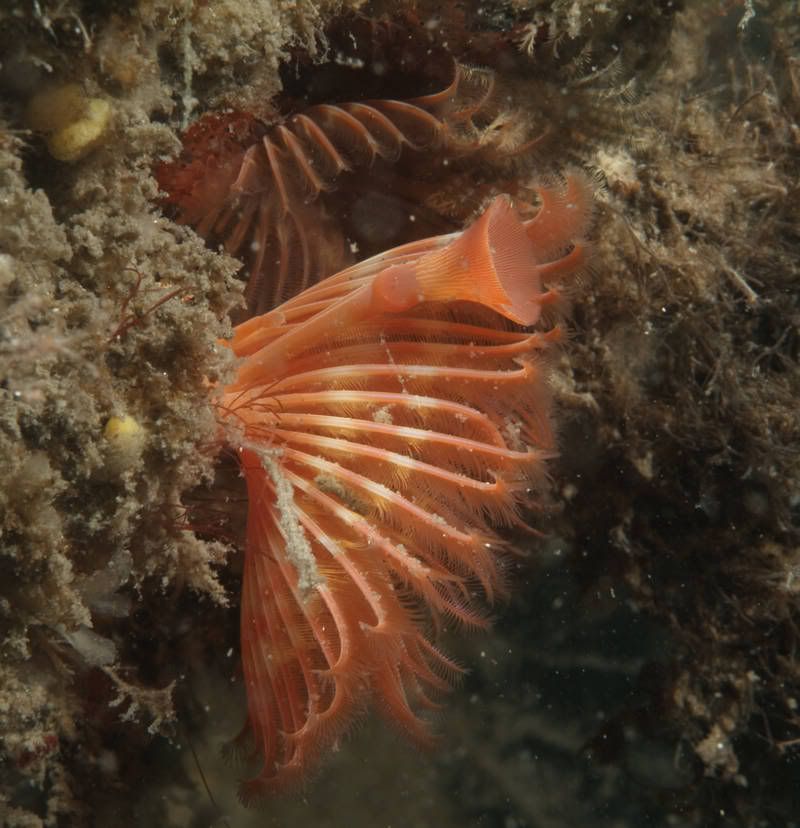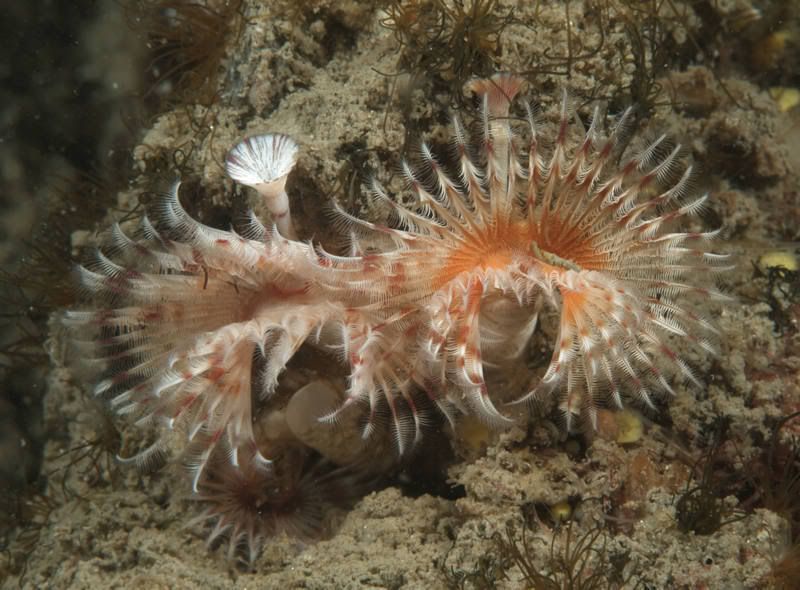| Pages:
1
2 |
Ken Bondy
Ultra Nomad
    
Posts: 3326
Registered: 12-13-2002
Member Is Offline
Mood: Mellow
|
|
Nena and Sally, they have a hammer-like claw that they use to stun/kill prey, and for defense. They are big, often a foot long, and the impact from
the hammer claw has been known to break fingers and dome ports on cameras. And they probably have high cholesterol, but I can't confirm that CaboRon
 . .
++Ken++
|
|
|
CaboRon
Ultra Nomad
    
Posts: 3401
Registered: 3-24-2007
Location: The Valley of the Moon
Member Is Offline
Mood: Peacefull
|
|
Beautiful and Dangerous
Beautiful and dangerous ! It looks as if you are within macro distance.... within reach of that hammer claw. Care to comment briefly on your
equipment for capturing these stunning photos. CaboRon
|
|
|
Skipjack Joe
Elite Nomad
     
Posts: 8088
Registered: 7-12-2004
Location: Bahia Asuncion
Member Is Offline
|
|
Does anyone know what that trumpet-like structure may be?

|
|
|
Ken Bondy
Ultra Nomad
    
Posts: 3326
Registered: 12-13-2002
Member Is Offline
Mood: Mellow
|
|
@CaboRon - I used a Fuji S2 Pro DSLR camera with a Nikon 60mm Micro lens in a Subal housing, two Nikon SB105 strobes.
Igor, the trumpet must be pretty fundamental because they all have one:


|
|
|
Ken Bondy
Ultra Nomad
    
Posts: 3326
Registered: 12-13-2002
Member Is Offline
Mood: Mellow
|
|
Igor
This is possibly more than anyone needs to know about tube worms, but that trumpet-shaped thing is called an operculum. It is used to seal the top
of the tube when the worm retracts the crown back inside the tube. They can do that instantly when they are approached too closely, just a "poof" and
the are gone. What did I do before they invented google? 
|
|
|
Skipjack Joe
Elite Nomad
     
Posts: 8088
Registered: 7-12-2004
Location: Bahia Asuncion
Member Is Offline
|
|
Ken,
It was a rhetorical question. I was planning to use it to introduce some drawings about these worms I made a very long time ago.
I thought about the operculum and what function it may serve. I think that in addition to many others it probably keeps unwanted debris from entering
the tube. Imagine the animal feeding in a tide pool and water washes over the side. It pulls in it's tentacles and plugs up the opening to keep all
those sand particles from entering. I say this because I don't think it could really provide much protection from predators.
|
|
|
Ken Bondy
Ultra Nomad
    
Posts: 3326
Registered: 12-13-2002
Member Is Offline
Mood: Mellow
|
|
| Quote: | Originally posted by Skipjack Joe
Ken,
It was a rhetorical question. I was planning to use it to introduce some drawings about these worms I made a very long time ago.
I thought about the operculum and what function it may serve. I think that in addition to many others it probably keeps unwanted debris from entering
the tube. Imagine the animal feeding in a tide pool and water washes over the side. It pulls in it's tentacles and plugs up the opening to keep all
those sand particles from entering. I say this because I don't think it could really provide much protection from predators. |
Ya got me! l should have realized it was rhetorical. Of all people you would know what the operculum was  Anyway at least I learned what it was. I have seen them a few thousand times and, until you asked the question, I
didn't know what that wooger was! Anyway at least I learned what it was. I have seen them a few thousand times and, until you asked the question, I
didn't know what that wooger was!
++Ken++
|
|
|
Natalie Ann
Ultra Nomad
    
Posts: 2819
Registered: 8-22-2003
Location: Berkeley
Member Is Offline
|
|
| Quote: | Originally posted by Skipjack Joe
Ken,
It was a rhetorical question. I was planning to use it to introduce some drawings about these worms I made a very long time ago.
|
So Igor, ya gonna show us the drawings or what?!
Be yourself, everyone else is already taken.
.....Oscar Wilde
|
|
|
Skipjack Joe
Elite Nomad
     
Posts: 8088
Registered: 7-12-2004
Location: Bahia Asuncion
Member Is Offline
|
|
Ken and Natalie,
I don't know if people are interested about what these animals are but I think some might be. So I thought it might be helpful to see what's inside of
the tubes.
This is a drawing of the external morphology of the animal. A problem with living in a tube is going potty. These animals collect their poop and pass
it outward from cilia to cilia along the body until it's at the crown. A lot is done with currents. They have dedicated cilia at the front that create
a current that finally rids the matter

|
|
|
Skipjack Joe
Elite Nomad
     
Posts: 8088
Registered: 7-12-2004
Location: Bahia Asuncion
Member Is Offline
|
|
When you look at the crown of the worm you may get the impression that they are passively filtering water as it flows past their tentacles. Actually,
it's more interesting than that. They have small hair like projections in the crown that 'beat' or 'row' in unison creating small currents that funnel
water into their mouths. As the diatoms adhere to the tentacles the food is transported into the center. You can see this happening well by adding dye
in small amounts near the crown and looking through a dissecting scope.

|
|
|
Skipjack Joe
Elite Nomad
     
Posts: 8088
Registered: 7-12-2004
Location: Bahia Asuncion
Member Is Offline
|
|
This last drawing shows the rejection path on both sides of the body leading to the central outward current that finally disposes the matter.

|
|
|
Gnome-ad
Nomad
 
Posts: 156
Registered: 6-4-2007
Location: Todos Santos, BCS
Member Is Offline
Mood: Okey-Dokey
|
|
Ken Bondy - WOW! Thank you so much for sharing your beautiful photos. Amir told me to check this thread. I'm sure I will never tire of your stunning
images. And the way you can find photos of other fringeheads or shrimp when asked about them is also impressive. The first fringehead in the post is
really checking you out.
The shrimp is amazing! Definitely beautiful and sounds quite dangerous!
And thanks Skipjack Joe. I enjoy anatomical drawings and yours are not only educational, but also superbly drawn. Great to have such informative
posts!
The only normal people are the ones you don't know very well. - Ancis
|
|
|
Natalie Ann
Ultra Nomad
    
Posts: 2819
Registered: 8-22-2003
Location: Berkeley
Member Is Offline
|
|
| Quote: | Originally posted by Skipjack Joe
They have small hair like projections in the crown that 'beat' or 'row' in unison creating small currents that funnel water into their mouths.
|
Those hairs rowing in unison... what an image that brings. Do ya 'spose there's one little hair on each tentacle which beats a drum and calls "yo ho
heave ho"?!
Seriously... thank you Igor for that marvelous explanation with drawing of the most personal dynamics of a tube worm. And here all this time I
thought they were just pretty. 
Be yourself, everyone else is already taken.
.....Oscar Wilde
|
|
|
Ken Bondy
Ultra Nomad
    
Posts: 3326
Registered: 12-13-2002
Member Is Offline
Mood: Mellow
|
|
Magnificent Igor. Can I ask when you drew those?
++Ken++
|
|
|
Skipjack Joe
Elite Nomad
     
Posts: 8088
Registered: 7-12-2004
Location: Bahia Asuncion
Member Is Offline
|
|
The notebook says December 13th, 1973. About 35 years ago. It was fun going through it again.
I've got some good ones on the feeding mechanisms of mussels, hermit crabs, and a variety of other inverts. Perhaps when the time seems appropriate
I'll post some others.
|
|
|
Wingnut
Nomad
 
Posts: 171
Registered: 5-5-2007
Location: Phoenix, AZ
Member Is Offline
Mood: Baja Pensive
|
|
Wow. Awesome stuff guys. We need to add another discription to the Nomad site. Home of seaworthy education. Fascinating stuff, thanks to all!
|
|
|
| Pages:
1
2 |

